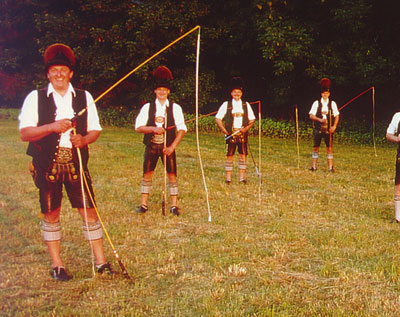Chiemgau costume
The Chiemgau costume is a costume worn in the Chiemgau area .
The traditional costume is maintained by traditional costume associations , mountain riflemen , music bands and also many boys' associations . Many residents of the Chiemgau have traditional costumes without being part of a traditional costume club or similar. to be. The Chiemgau costume is - like today's Upper Bavarian mountain costumes in general - not a historical garment in the scientific sense. It only developed in the period before 1900 with the spread of traditional costume clubs in Upper Bavaria.
Components of the male costume
cap
There are three common hat shapes for the Chiemgau men's costume:
- The Aschauer hat, a pointed green hat made of velor, often slightly indented on the side
- The round disk from Berchtesgaden
- The Hohenaschauer stopper hat (only worn by the GTEV D'Griabinga Hohenaschau)
Similar to the uniform headgear, it is not removed by people in traditional costumes, exceptions are entering the church and church activities in the open air. Various hunting trophies are common as hat decorations. In traditional costume clubs, chamois beards , eagle fluff or cock feathers are worn depending on the club membership .
shirt
The shirt is usually made of ivory-colored linen or cotton with mother-of-pearl buttons or linen buttons. The initials are often cross stitched or stitched into the bridge.
Lederhose with suspenders
The original Chiemgauer Lederhose is made by hand. The shorts have richly embroidered ornaments in yellow or lime green. The design of the ornaments is mostly based on very old templates. The trousers have a bib at the front, are tied with ribbons at the bottom and have a knife pocket on which the initials can be embroidered. The trousers of active Schuhplattler often look as if they were made of nappa leather. This look is created by rubbing in milking fat , which makes the beat louder. The knee breeches usually have a white trim, typical is the application of a plate seam on the buttocks.
The leather strap of the suspenders is between 2 and 3 cm wide, crossed at the back (often held by a silver clasp) and has the clasps above the table. Elaborate tables have old embroidery, horn decorations or the King Ludwig plaque. Outside the traditional costume clubs, the so-called Norwegian carrier or Kraxn is also widespread.
Loaves (vest)
A green loaf is worn with the costume. The front in felt , the back in black or green silk, swallow pockets (curved) or box pockets and silver buttons. At the top, the vest is closed with one or two silver button chains.
Jacket or forest green suit
The Chiemgau jacket is worn in gray, forest green or lime green. The jacket is not slit at the back and often has light green oak leaf felt applications. For special festivities and funeral services, a "forest green suit" is worn, consisting of forest green trousers, green loaf and forest green Chiemgau jacket.
Stockings and shoes
Light gray woolen stockings that reach down to the knee and are often artistically embroidered in green are worn, as well as calf stockings (Loferl) with yellow or light green decorations with shorts. Haferl shoes with side lacing are worn with traditional costume . The shoe is made of black leather with green embroidery, a light, thin leather sole and has a flat heel.
Jewellery
In addition to other jewelry, brooches or needles are often worn on the jacket (mostly awards from the prize plate or other honors). If these are not too big, they can also adorn the hat. Between the two outermost front buttons of the lederhosen a shariwari, a chain with various old coins, claws, horn carvings or the like, is worn. A silver pocket watch with a spring cover is often worn with the costume.
The mandatory laterally supported in the blade pocket knife , there are two different ways: deer or stag or Goasfuas. The horn knives are usually shod with silver or decorated with horn carvings. The Goasfuas is in reality mostly a deer foot into which the blade has been worked.
Components of the women's and girls' costume
cap
There are two common hat shapes for women and girls in Chiemgau:
- The Priener Hut , a cylindrical hat designed around 1894 with gold tassels and mostly with a velvet ribbon
- The Aschauer hat, often with cock feathers
garment
The costume of the unmarried dirndl includes a bodice with a skirt hook attached to it, a hand-strung skirt with a white blouse, apron, fringed cloth, white long cotton stockings or tights and black leather traditional shoes. The typical colors for the skirt are black, green and wine-red (rarely blue - is more common in the Miesbacher and the traditional costume of the Oberland) and always black for the bodice, and light blue, pink, lime green or natural for the apron and the scarf red-green rose pattern (e.g. Bernau).
Married (older) women wear so-called "Röcki" made of black hand-strung silk as traditional costume. It consists of a calf-length skirt richly decorated with braids, lace or frog mouths (the skirt must not be longer than there is space for a beer mug underneath) and an apron. Black leather shoes, black opaque silk stockings and, as a rule, the Priener hat with an embroidered velvet ribbon or taffeta ribbon are worn.
Jewellery
In addition to the obligatory hat jewelry, jewelry includes a velvet collar or a multi-row necklace ("crop chain") as well as hair accessories and earrings. Flower decorations are also worn on festive days.


